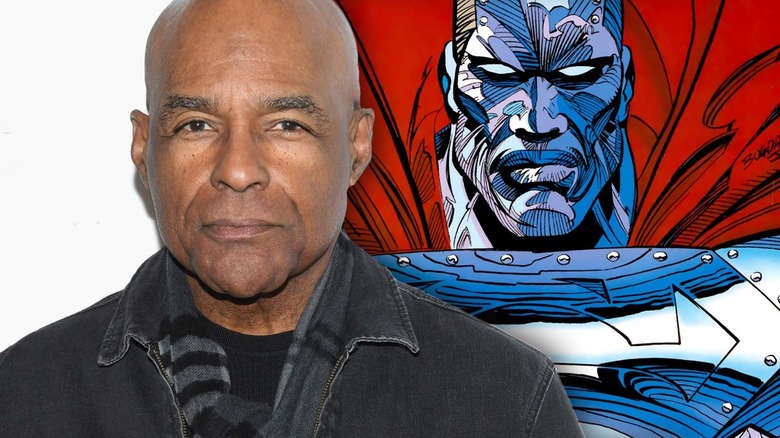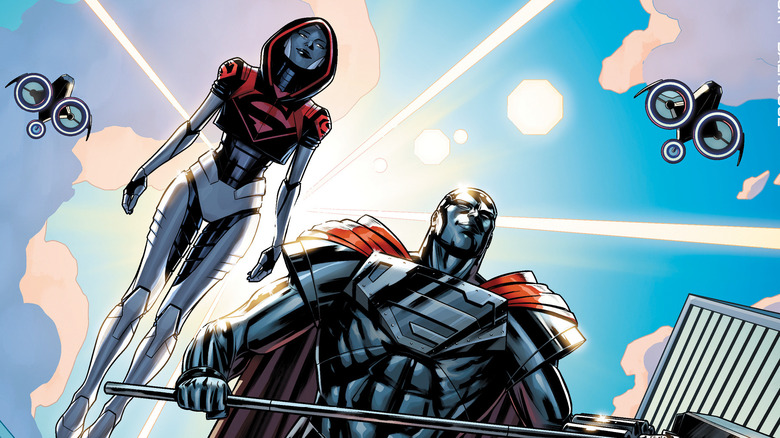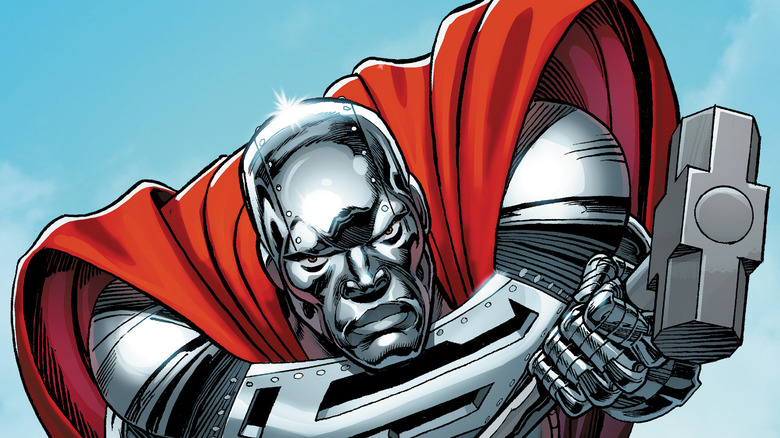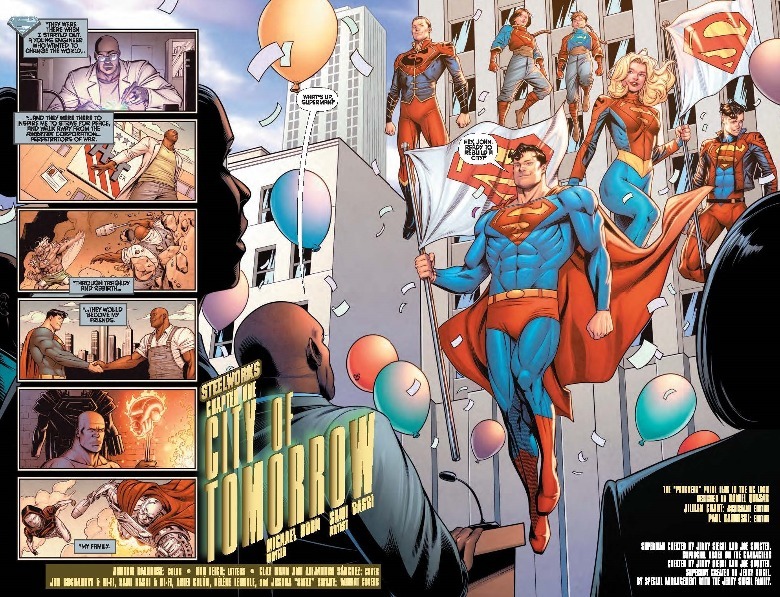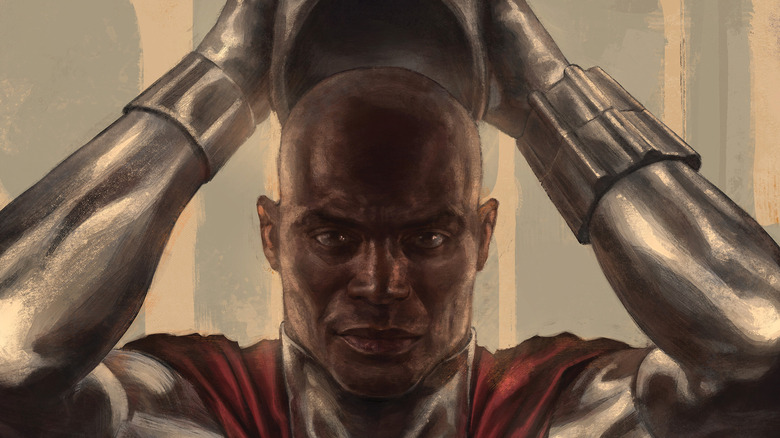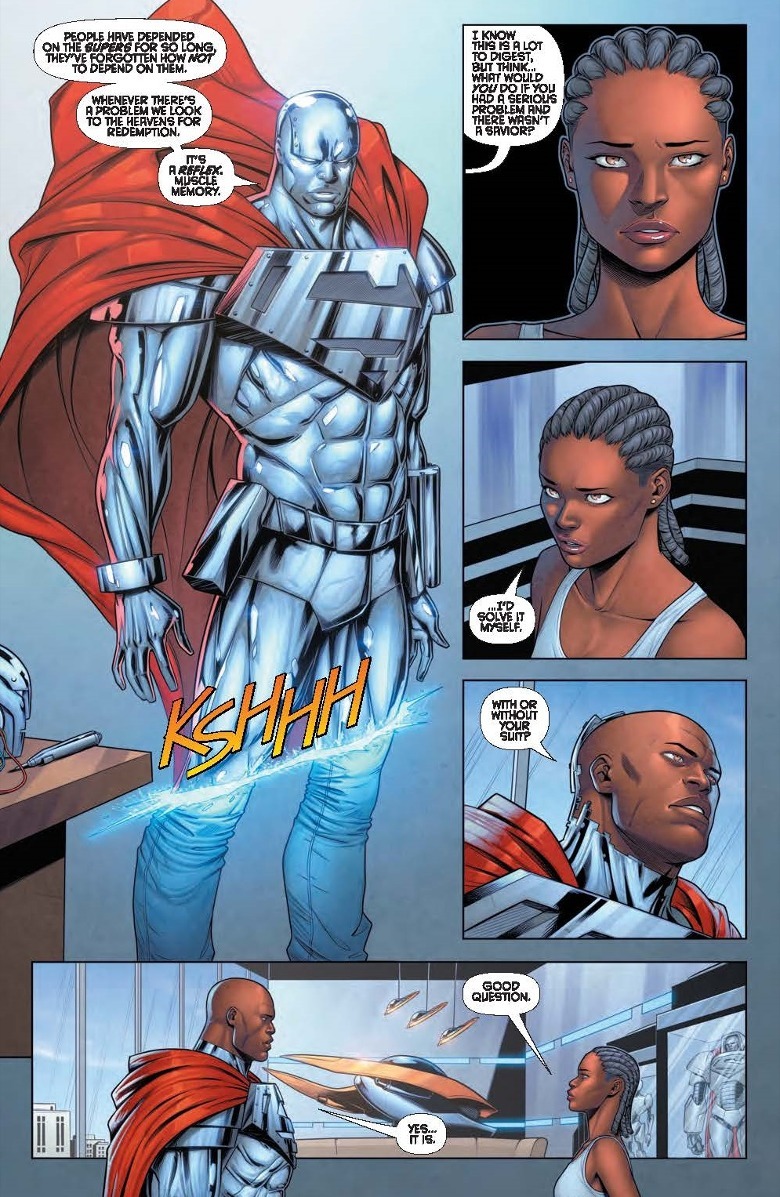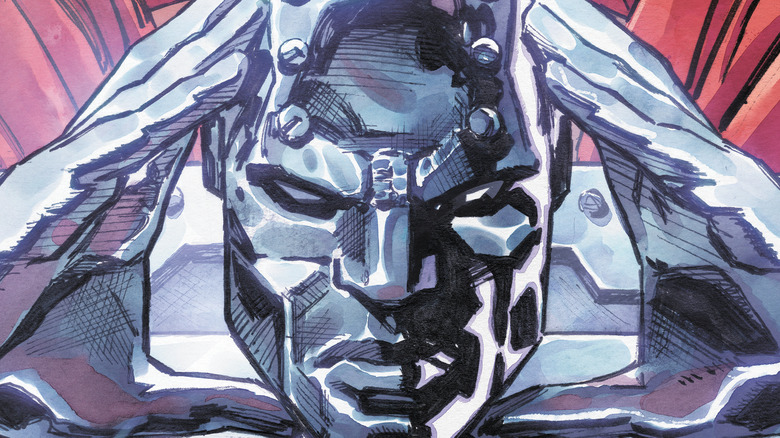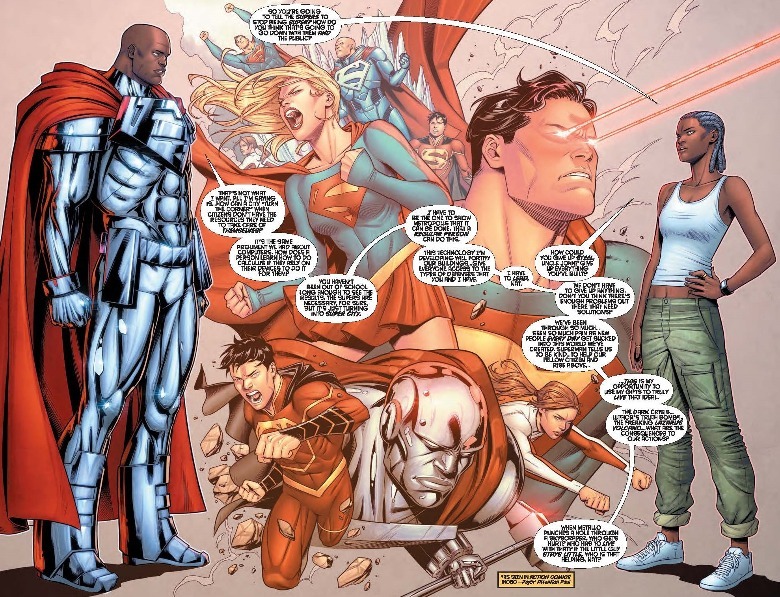Michael Dorn Returns To DC's Steel In The Most Intimate Way Yet - Exclusive Interview
"Stark Trek" actor Michael Dorn is taking on an all-new role as a comic book writer for DC Comics, penning the upcoming "Steelworks" series for DC Comics. Dorn, who has appeared in multiple iterations of "Star Trek" — most famously portraying the Klingon Worf in "Star Trek: The Next Generation" and reprising the role recently in "Stark Trek: Picard" — already has a special connection to Steel, voicing John Henry Irons in the critically acclaimed "Superman: The Animated Series." Now, more than two decades after helping bring Steel to life on the small screen, Dorn is teaming up with artist Sami Basri, colorist Andrew Dalhouse, and letterer Rob Leigh for a brand-new comic book focusing on Steel and his family.
Dorn's new six-issue miniseries will see Irons try to make Metropolis a better place alongside the Superman Family through the rise of the Steelworks organization. At the same time, the hero considers hanging up his hammer and armor for good. We spoke with Dorn about tackling the character again through a new medium, bringing Steel back to the forefront of the DC Universe, and what readers can expect from the new series.
How Michael Dorn returned to Steel and the DC Universe
Firstly, how'd this opportunity come to be, and what was it like to jump back into the world of Steel after voicing him in the animated series?
You'd have to ask the people at DC Universe how the idea germinated. But I got a call, and they said, "We would like you to be involved in this project," and they explained it to me. I said, "Well, how do you want me to be involved?" They said, "We want you to be involved — whatever you want to do." I went, "If I'm going to put my name to anything, I want to write it and at least be an important part of that process."
They said, "Sure. That sounds great." We took a couple of months after for them to get their stuff and my stuff and contracts ... But then we started in earnest, and it's been [an] interesting and collaborative and rewarding project. That's where we are.
Voicing is one thing because you're voicing a character that's already been drawn and animated. You're just the voice, and you come in and say a bunch of lines and leave. This was a great opportunity, a really good opportunity, and an interesting opportunity to actually do something creative about the character.
How was it writing Steel versus voicing him?
In terms of the creative side, it's no different than writing a character or writing a regular or a script or a screenplay or a TV show or pilot — whatever the case. That's no different from that process. But the mechanics of it is different because there isn't a template on Final Draft or on Microsoft Word or anything that is like, "This is the template for a comic book."
The first script I turned in, they said, "Hey, Michael, that's good. We can work with it, but could you write it in this way?" They sent me a whole file with what it looks like when they get it from guys that write comics all the time. I went, "Oh, that's different." But it wasn't difficult. It wasn't like, "Oh my God, I don't know if I could do this." It was just a matter of another template that you have to do.
The other thing where you have to walk the fine line in movies and TV is descriptions, because you can't spend a whole page describing something. That's what the other thing is — you had to be very specific in your descriptions about what's going on and what you see. That was different, but they've been very helpful, so it was an easy transition.
On the differences between acting and writing
Over the last year, you've returned to not only the DC Steel world, but you've also come back to "Star Trek." How have those experiences paralleled each other? They're quite different in terms of the medium, but is it something you ever envisioned, returning to your past roles?
No. This is what drew me to this ... When you're an actor, you have really no say about the character. You do have some, but in the whole machine, you're basically there. We have a saying that we used to say — our job is to know our lines, come on the set, and don't bump into the furniture. That's great; I did it for many, many years, but I also had an opportunity to direct and to have something start from the very beginning, which is what drew me to this in the first place.
As an actor, you're not creating anything from the very start. As a writer, you are. I'm not creating the character, but the theme or the throughline of what this series is going to be is something that I created.
It is still in the vein of their character. He's not going off and becoming a clown in a circus, but it definitely ... I'm able to create within that world. I can look at the comic and go, "I wrote that. That's the idea, and they ran with it." I absolutely love it.
With the current state of the Superman expanded family, how important was it to put Steel back in the forefront? And what was it like to play in the Steel/Superman universe in such a big way?
It's very interesting. It's not as freeing as you would think it is. These are well-written and fleshed-out characters, basically. In terms of who they are, what they do, and where they came from, all that is already there, so you don't have to go back to that stuff. But you're able to play ... They give you, "Okay, you can't go here, you can't go here, but you can play all you want to in here." That's the way I look at it.
For instance, there was a thing where we have to see him in his suit. You have to. He can't, in the first issue, just hang it up, [like], "I'm not going to do that anymore." That's not what people want to see. This is something that the editors and everything know. That's the kind of thing that you have to play in, which is not a big deal. I understand it, and it makes sense.
What was it like to work with Sami Basri and Andrew Dalhouse on this project?
I've never met them, but I'm always in awe of artists — always. I wrote a script recently, and I had to have storyboards for half the movie. Artists are amazing ... I'm a little jealous because I'd like to do that. I'd like to be able to whip that up. There [are] times when you go, "Tweak that a little bit," or, "Oh, that's interesting." But I'm in awe of what they do, and it's been great. The artwork is amazing.
The interesting thing is that I used to read a lot of comic books, but I haven't read comic books in 40 years or something like that — maybe longer. So this is all new to me, and it's been an eye-opening ... Even though I've seen it and I get it, having me be a real part of it is amazing. It's art, and I love art.
Steel's relationship with being a hero and how it conflicts with those closest to him
The comic finds Steel at an odd spot with his superhero persona. How does that affect him and his family in this book, and how does his mission conflict with what Superman's trying to do in Metropolis?
Everybody is at odds, and I think that's a good place to start. Some people are going, "Are you crazy?" and some people are going, "Well, yeah, kind of." Some people go, "Hey, I see what you're talking about." I like the idea that Superman goes, "I see what you're talking about. How are you going to do it? Tell me your idea." That is how all of these things will work themselves out.
Initially, it's the idea that he's thrown a curve — not a bomb, but a curve. As we see, even superheroes can be like, "I don't understand any of this." They understand keeping buildings from falling and catching bad guys, but what about your own thing? What happens with all of that? That's what I like, along with all the flying and the saving people.
How does Steel's relationship with Natasha drive the story and conflict with his thoughts on being a hero? Because while he's eager to hang up the cape and go to a new tomorrow, she's not.
That is the dilemma that he has, and the dilemma that he has is her dilemma, also, in a different way. Her dilemma is ... I'd like to think that she's going, "Hey, I like this. You may not, but I like it." There is going to be ... We haven't delved into that, so it's not anything that we've written. But those are issues that we are definitely going to touch on. It's the idea that some people will go, "Not a bad idea." Some people will go, "Maybe we need to pivot," and some people will go, "No, I love this." He has to deal with each one of those attitudes, especially with his niece. That's family.
I don't want to get too political, but because of our political atmosphere recently, you see families being fractured and friendships being fractured because of political ideals. As a person, you have to deal with those things. If it was a guy that you worked with and you only see him at work, you go, "Well, he's an oddball," or whatever the case. But if it's your family that you see every day — or you see four times a day or four times a year for family dinners — you got to deal with them differently than a guy on the street.
What readers can expect from the new Steelworks series
Are there any other DC characters you'd like to tackle now?
I'd like to stick with John Henry. I like the depth. I don't know. They sent me the first issue that featured him — kind of dark. You're talking about a guy who's lost everybody violently, and that is something that can be explored even more. So there's nobody else.
There's a lot of characters in the DC universe, but because of the mythology and that I've been part of this whole thing for many, many years, that's something that I'd like to continue to explore. We only have a certain amount of time and a certain amount of ... You have 20 or 25 pages to explore all these things, and even six issues are not enough. So I would like to continue that. It's fertile ground.
With the book coming out sooner than later, how excited are you to reintroduce John Henry Irons in his own series, and what do you hope readers get from this?
What I hope for ... I want the people that read comic books — that are comic book people — to enjoy it. But I want to plant a little seed into the comic book that's like when we watched science fiction when we were growing up. It was monsters and giant ants and giant grasshoppers and all that, but as you got older, you see what they were trying to do. I'd like to plant this little seed where people will read it and go, "Wow, that's exciting. Oh God, this is great. It's fun. We really like it," and then go, "Huh," where the seed is growing and making them think a little differently — not so much about the comic, but about their own life.
That's what I'm hoping. It's a little ambitious. When I say it like that, it's like, "Who do I think I am? Tolstoy?" But that's what I hope.
Here's the official text solicitation of "Steelworks" #1 by DC Comics, which arrives in comic book stores on June 6, 2023.
FORGING THE FUTURE! The Metropolis of the future is here today, but can it survive a terrorist who's out for revenge against its builder — John Henry Irons, aka Steel —and his company, Steelworks ... and who possesses secrets that could undo everything John has worked so hard to build?
While John's professional life is firing on all cylinders, his personal life is even better, as his on-again, off-again relationship with Lana Lang might be back on, permanently. Now he must decide whether it's time to give up being Steel once and for all. But does John even know who he would be without his superhero identity? How does the other Steel — John's niece, Natasha Irons — feel about his momentous decision? And does any of that matter if Steelworks crumbles around him when he lacks the superpowers to fight back? Writer Michael Dorn (the voice of Steel in "Superman: The Animated Series") teams up with artist Sami Basri ("Harley Quinn," "Catwoman") to bring you the next chapter of Steel's saga in this not-to-be-missed six-issue miniseries!
This interview has been edited for clarity.
